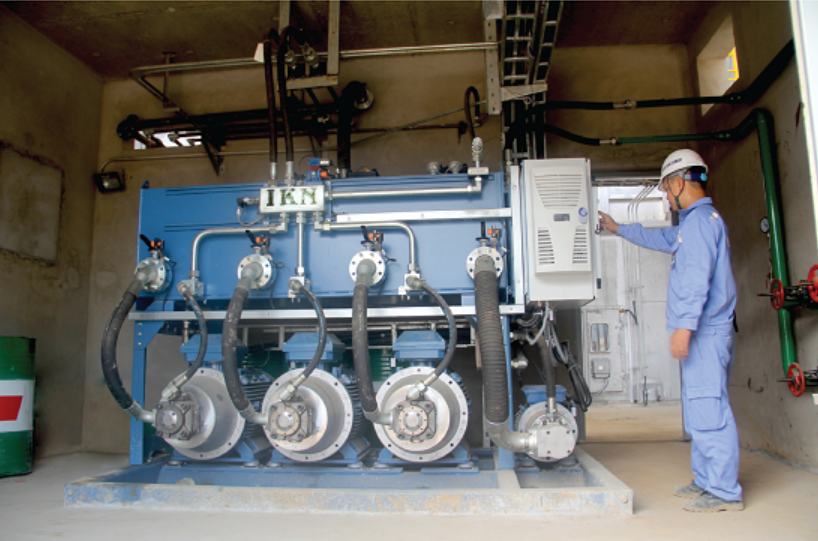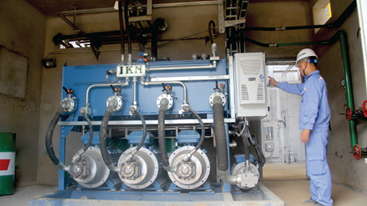Long Son Cement Joint Stock Company (Long Son Cement Plant) is one of many enterprises in Thanh Hoa province that has actively promoted the application of new science and technology in the production of renewable electricity for its manufacturing processes, aiming to reduce costs and secure an independent power supply for production and business activities.

The grinding system using German technology at Long Son Cement Plant.
The Long Son Cement Plant, with four synchronized, modern production lines with a production efficiency of over 10.5 million tons per year, is one of the most technologically advanced cement factories. Almost all the equipment installed in the plant has been directly imported from Germany and Switzerland, combined with advanced production technology from Japan. The raw materials are sourced from the Bim Son mountain area, which is considered the best in Vietnam for developing the cement industry. This facility produces high-quality cement that meets international standards.
Mr. Truong Van Loi, Production Director of Long Son Cement Plant, stated: "Long Son Cement Plant consumes over 600 million kWh per year, equivalent to nearly VND 1,000 billion per year. Throughout its development, the company has always been conscious about using energy efficiently, saving non-renewable resources, and protecting the environment.
Specifically, during the clinker production process, residual heat is generated. Without a recovery system to utilize this heat for power generation, it would dissipate into the environment, causing pollution and contributing to global warming. Therefore, in recent years, Long Son Cement Plant has been utilizing this residual heat to generate electricity, serving the plant's production needs directly and contributing to the national power grid, thus alleviating the burden on the power sector."
Long Son Cement Plant has installed a comprehensive waste heat recovery system, including an SP system that captures heat from behind the heat exchange tower, and an AQC system that captures heat from the clinker kiln and cools the clinker, for power generation. Thanks to this waste heat recovery system, the plant produces 260 million kWh of electricity each year, meeting 30% of the plant's electricity needs. It is estimated that the plant saves nearly 400 billion VND annually from this system.
"We are investing in a waste heat recovery system to generate electricity with a capacity of 35MW. To date, we have generated electricity and saved about VND 80 billion," Mr. Truong Van Loi shared.
Mr. Truong Van Loi, Director of Long Son Cement Plant
To enhance energy-saving efficiency, Long Son Cement Plant also strengthens the implementation of other electricity-saving measures such as installing and replacing lighting systems with energy-saving lights; designing and installing inverters to save energy; designing and programming automatic water discharge valve systems for air compressor surge tanks; modifying energy-saving program. Additionally, the plant emphasizes raising awareness and encouraging its staff to actively save electricity during production and operations.
In addition to energy-saving measures, Long Son Cement is also committed to environmental protection to ensure sustainable development. The plant has installed modern equipment to minimize dust and noise pollution; wastewater is collected and treated through an automatic sedimentation and filtration system; and green spaces and balancing lakes are strategically placed around the plant to reduce the greenhouse effect and thoroughly address environmental impacts.
In the context of a highly competitive cement market with an oversupply, the implementation of energy-saving solutions, including the use of waste heat for power generation, benefits companies both economically and environmentally. This plays a crucial role in ensuring energy security and supports economic growth in conjunction with green production practices.
To develop an efficient and sustainable construction materials industry, which fundamentally meets domestic needs while progressively increasing exports and contributing to socio-economic growth, as well as effectively utilizing resources and thoroughly saving energy, raw materials, and fuel, the government has approved the Strategy for the Development of Vietnam's Construction Materials for the period 2021 - 2030, with an orientation towards 2050. Accordingly, by the end of 2025, 100% of cement production lines with a capacity of 2,500 tons of clinker per day or more must install and operate power generation systems that utilize waste heat for electricity production; by 2030, 30% of ash from thermal power or other industrial waste must be used as raw materials and additives in production.
Duc Do





.jpg?w=367&h=206&mode=crop)




.jpg?w=367&h=206&mode=crop) Notice for Contracts award for Support to Industrial Enterprises for Energy Audits and Preparation of Feasibility Studies (Package No. C2.2.4)
04/06/2024
Notice for Contracts award for Support to Industrial Enterprises for Energy Audits and Preparation of Feasibility Studies (Package No. C2.2.4)
04/06/2024
 Training Courses for Energy Managers and Energy Auditors
Training Courses for Energy Managers and Energy Auditors
 Vietnam Energy Outlook Report – Pathway to Net Zero
Vietnam Energy Outlook Report – Pathway to Net Zero
 Long Son Cement saves 30% of electricity consumption thanks to heat recovery
Long Son Cement saves 30% of electricity consumption thanks to heat recovery
 Expression of Interest: C2.1.15: Development of Energy-Efficient Technology Catalogs for the Industrial Sector
Expression of Interest: C2.1.15: Development of Energy-Efficient Technology Catalogs for the Industrial Sector
 Optimizing Compressed Air Systems for Southern Industrial Enterprises
Optimizing Compressed Air Systems for Southern Industrial Enterprises
 The Ministry of Industry and Trade Review the Energy Efficiency and Conservation activities in Lao Cai.
The Ministry of Industry and Trade Review the Energy Efficiency and Conservation activities in Lao Cai.
 EOI Extension: C2.2.2: Review and update for current EE benchmarking for 2 sub-industrial sectors
EOI Extension: C2.2.2: Review and update for current EE benchmarking for 2 sub-industrial sectors